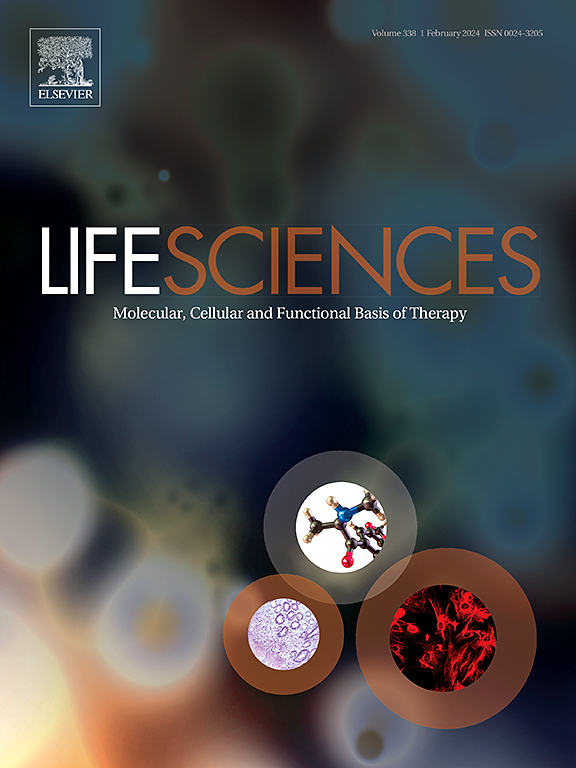ON101 counteracts oxidative stress and inflammation in radiation-induced dermatitis through Keap1/Nrf2 signaling
IF 5.2
2区 医学
Q1 MEDICINE, RESEARCH & EXPERIMENTAL
引用次数: 0
Abstract
Radiation-induced dermatitis (RID) remains a significant and challenging side effect of radiotherapy, with few effective topical interventions. This study investigates ON101 as a therapeutic candidate for RID, focusing on its modulation of the Keap1/Nrf2 signaling pathway. Using a murine model of radiation-induced skin injury, topical application of ON101 substantially reduced skin damage, as evidenced by decreased wound severity scores, preserved body weight, and improved histopathological outcomes. Histological analyses using H&E and Masson's trichrome staining revealed that ON101 and its active component, PA-F4, reversed radiation-associated dermal thickening and fibrosis, thus restoring skin architecture and elasticity. RNA sequencing demonstrated that ON101 treatment downregulated Keap1 expression, facilitating nuclear translocation and activation of Nrf2, a central regulator of antioxidant responses. Consistently, irradiated human keratinocytes (HaCaT) and dermal fibroblasts (HDFs) treated with ON101 exhibited significantly decreased levels of oxidative stress markers and pro-inflammatory cytokines, confirming its combined antioxidant and anti-inflammatory effects. Moreover, ON101 enhanced the expression of key genes involved in DNA damage repair and skin regeneration, including EGFR, VIM, and CTNNB1, highlighting its regenerative potential. Mechanistically, the study identified increased p62 and nuclear Nrf2 levels following ON101 treatment, confirming activation of the p62-Keap1-Nrf2 axis—a pivotal pathway governing cellular defense mechanisms against oxidative damage. Collectively, these results suggest that ON101 provides comprehensive protection against RID by modulating oxidative stress, reducing inflammation, and promoting tissue repair. Through these targeted molecular mechanisms, ON101 emerges as a promising topical therapeutic agent for managing radiation-induced cutaneous toxicity in clinical settings.

ON101通过Keap1/Nrf2信号通路对抗辐射性皮炎的氧化应激和炎症。
放射诱发性皮炎(RID)仍然是放疗的一个重要且具有挑战性的副作用,很少有有效的局部干预措施。本研究研究了ON101作为RID的治疗候选,重点研究了其对Keap1/Nrf2信号通路的调节。在小鼠辐射皮肤损伤模型中,局部应用ON101可显著减轻皮肤损伤,这可以通过降低伤口严重程度评分、保持体重和改善组织病理学结果来证明。H&E和马松三色染色的组织学分析显示,ON101及其活性成分PA-F4可以逆转辐射相关的真皮增厚和纤维化,从而恢复皮肤结构和弹性。RNA测序表明,ON101处理下调了Keap1的表达,促进了核易位和Nrf2的激活,Nrf2是抗氧化反应的中心调节因子。同样,ON101处理的辐照人角质形成细胞(HaCaT)和真皮成纤维细胞(HDFs)显示出显著降低的氧化应激标志物和促炎细胞因子水平,证实了其抗氧化和抗炎的综合作用。此外,ON101增强了EGFR、VIM、CTNNB1等参与DNA损伤修复和皮肤再生的关键基因的表达,凸显了其再生潜力。在机制上,该研究发现ON101处理后p62和核Nrf2水平增加,证实了p62- keap1 -Nrf2轴的激活-这是控制细胞防御氧化损伤机制的关键途径。总之,这些结果表明ON101通过调节氧化应激、减少炎症和促进组织修复提供全面的RID保护。通过这些靶向分子机制,ON101成为一种有前途的局部治疗药物,用于治疗临床环境中辐射引起的皮肤毒性。
本文章由计算机程序翻译,如有差异,请以英文原文为准。
求助全文
约1分钟内获得全文
求助全文
来源期刊

Life sciences
医学-药学
CiteScore
12.20
自引率
1.60%
发文量
841
审稿时长
6 months
期刊介绍:
Life Sciences is an international journal publishing articles that emphasize the molecular, cellular, and functional basis of therapy. The journal emphasizes the understanding of mechanism that is relevant to all aspects of human disease and translation to patients. All articles are rigorously reviewed.
The Journal favors publication of full-length papers where modern scientific technologies are used to explain molecular, cellular and physiological mechanisms. Articles that merely report observations are rarely accepted. Recommendations from the Declaration of Helsinki or NIH guidelines for care and use of laboratory animals must be adhered to. Articles should be written at a level accessible to readers who are non-specialists in the topic of the article themselves, but who are interested in the research. The Journal welcomes reviews on topics of wide interest to investigators in the life sciences. We particularly encourage submission of brief, focused reviews containing high-quality artwork and require the use of mechanistic summary diagrams.
 求助内容:
求助内容: 应助结果提醒方式:
应助结果提醒方式:


